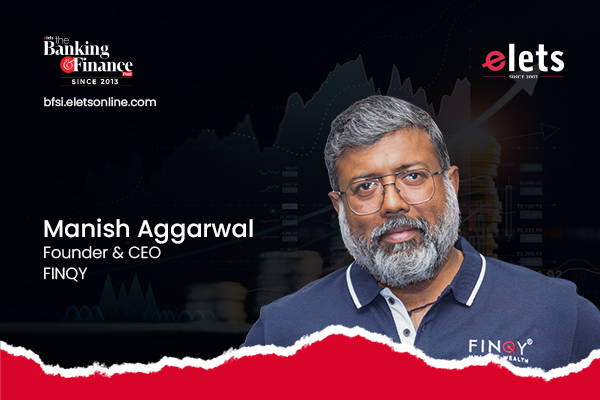Strong distribution networks, AI-led underwriting, and embedded finance are emerging promptly as the backbone of financial inclusion in India’s next growth phase. As NBFCs evolve into tech-enabled platforms, players like FINQY are empowering local intermediaries and DSAs with digital capabilities that rival large institutions. By blending compliance-ready infrastructure with contextual innovation, they are unlocking new credit pathways for underserved segments. Shared Manish Aggarwal, Founder & CEO of FINQY, in an exclusive interaction with Vishwas Sinha of Elets News Network (ENN). Edited excerpts:
The RBI’s evolving stance on co-lending models has significant implications for NBFCs. How do you perceive these regulatory changes affecting the collaboration between NBFCs and fintech platforms like FINQY?
The RBI’s evolving stance on co-lending is a step toward bringing more structure and transparency to partnerships between NBFCs and banks. For platforms like FINQY, it underscores the importance of strong compliance and technology-driven governance. Co-lending models thrive on trust and seamless coordination—FINQY acts as the digital bridge between lenders, fintech distributors, and end consumers. Our tech stack ensures accurate risk-sharing, real-time disbursal tracking, and transparent reconciliation, making us a valuable enabler in this ecosystem.
FINQY aims to revolutionize the traditional financial distribution system. Could you elaborate on how your platform empowers NBFCs, DSAs, and local intermediaries to enhance financial access across diverse Indian demographics?
At FINQY, we believe distribution is a massive moat for financial services. Our platform equips thousands of DSAs, agents, and small NBFCs across Tier 1 to 3 cities with digital tools that rival those of top banks — CRM systems, real-time eligibility engines, product comparison dashboards, and instant payout mechanisms. This levels the playing field and enables hyperlocal players to serve their communities more effectively, bridging the last-mile gap that traditional institutions often miss.
How is FINQY integrating AI and data analytics to facilitate smarter financial decision-making for consumers, especially in underserved regions?
We leverage AI to simplify choices and personalize recommendations. Our proprietary engines like “Test My Loan” and “Q Report” use behavioral data, income proxies, and credit history to match users with the right financial product—sometimes even before they know they need it. In underserved regions, where formal credit data is often sparse, we use surrogate data signals and alternate risk models to generate meaningful insights for lenders while keeping the customer journey frictionless.
Could you share insights into any recent partnerships or collaborations that FINQY has undertaken to bolster its mission of financial inclusion? How do these alliances enhance your service offerings?
To grow our credit card distribution network, we created a unique channel partner model called G5 – “Group of Five” comprising some of the biggest credit card distributors in India. This model enables us to reach smaller DSAs in West, North and South India while aligning individual partners with FINQY. We also recently partnered with KarmaLife, an NBFC aggregator, to facilitate advance payouts to our DSA partners. This is a game-changer, as it allows DSAs and freelancers to access their earnings seamlessly. Additionally, we’re collaboratiing with leading NBFCs to offer tiered products for varying risk segments. Every partnership we pursue is rooted in enhancing access and awareness for the partner community.
Digital lending is rapidly transforming the financial landscape. What trends do you foresee in digital lending, and how is FINQY positioning itself to stay ahead in this dynamic environment?
The next wave in digital lending will be driven by contextual finance—embedding credit at the point of need, whether it’s in an e-commerce app or an employee portal. We’re building modular APIs and white-labeled journeys that allow our partners to offer lending experiences within their ecosystems. We also foresee a shift from product-push to need-based financial advisory backed by technology, and we’re aligning FINQY’s interface to offer financial nudges, not just products.
A recent study highlighted the BFSI sector’s unpreparedness for quantum computing threats. How are companies approaching cybersecurity to safeguard against emerging technological risks?
Cybersecurity can’t be reactive anymore. At FINQY, we adopt a zero-trust architecture, run regular CISA audits, and ensure encryption standards that go beyond mandatory compliance. As new technologies like quantum computing emerge, we’re investing in scalable and adaptive security infrastructure, including collaborations with third-party security firms to simulate stress scenarios. The goal is simple—secure trust at scale without slowing down innovation.
Embedded finance is gaining traction globally. How is FINQY exploring embedded finance solutions to integrate financial services seamlessly into consumers’ daily lives?
Embedded finance is not the future — it’s now. FINQY is enabling MSMEs to offer advance loans to partners & employees, auto dealers to bundle car loans, and DSAs to cross-sell financial products — all to their captive customer base. Our plug-and-play infrastructure and financial product API suite allow any business to become a financial distributor without the heavy tech lift. That’s how we scale inclusion—by integrating into lives, not just apps.
Despite progress, MSMEs and informal borrowers still face credit access challenges. What role can tech-led NBFCs play in narrowing this credit gap effectively?
MSMEs face a double-blind spot — thin financial histories and lack of awareness. Tech-led intermediaries like ours decode this with alternative underwriting models that factor in GST data, utility bill patterns, and even WhatsApp-based business behavior. More importantly, we simplify the onboarding and document journey for first-time borrowers, making formal credit less intimidating. It’s about blending empathy with technology.
What areas or segments do you believe represent the next frontier for fintech innovation in India’s NBFC space—insurance, agri-finance, gig economy?
The gig economy and rural agri-finance are ripe for disruption. Both have underpenetrated demand, but conventional models fail to understand their cash flows. At FINQY, we’re exploring insurance-led lending for farmers and microloans tailored for platform workers. These segments require new scoring models, contextual delivery, and vernacular UX—challenges we’re excited to solve in the next leg of our journey.
Also Read: Empowering Bharat: The NBFC-MFI Approach to Inclusive Growth
What are the key challenges in scaling digital financial services across India, and how do you envision overcoming them in the next 3–5 years?
The biggest barriers are trust, digital literacy, and inconsistent data availability. To overcome these, we’re focusing on human-assisted digital journeys, where a local agent helps the customer navigate tech-enabled systems. We’re also investing in regional language interfaces and education-led campaigns. Over the next 3–5 years, I see India moving toward a hybrid distribution model—part tech, part touch—and FINQY will be at the forefront of that transformation.
Elets The Banking and Finance Post Magazine has carved out a niche for itself in the crowded market with exclusive & unique content. Get in-depth insights on trend-setting innovations & transformation in the BFSI sector. Best offers for Print + Digital issues! Subscribe here➔ www.eletsonline.com/subscription/















